This was published 8 months ago
Schlocky horror show is long on spectacle and short on drama
By Peter McCallum, John Shand, James Jennings, Harriet Cunningham and Joyce Morgan
FRANKENSTEIN
Theatre Royal, October 2
(Until October 13)
Reviewed by JOHN SHAND
★★★
Can we stop with the Gothic for a while now? Before Frankenstein loomed over us, Sydney had already been menaced by Dracula, Frame Narrative, The Woman in Black, The Turn of the Screw, Gaslight and the mock-gothic Rocky Horror Show. Frankenstein often felt rather more mock than Gothic, too – something author Mary Shelley assuredly did not intend. But then on stage, the distance between mock and Gothic is only the thickness of a shadow.
Sometimes an adaptation is made more in the image of the adaptor(s) than the original. British playwright Nick Dear’s engrossing 2011 Frankenstein revealed a man intent upon exploring the psychologies of Victor Frankenstein and the Creature he creates. This one, devised by the artistic directors of Brisbane’s Shake & Stir Theatre Co – Nelle Lee (adaptor), Nick Skubij (director) and Ross Balbuziente (creative producer) – instead wants to wow us into submission.
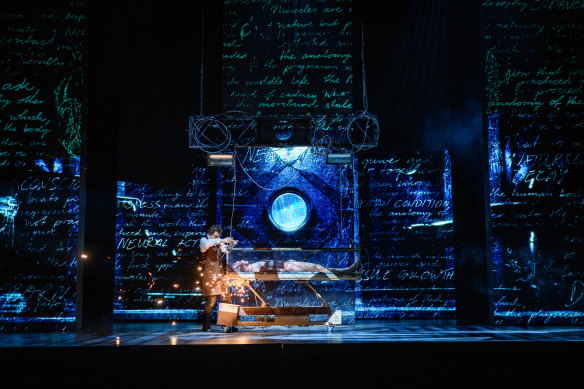
Frankenstein is big on flashy spectacle.Credit: Joel Devereux.
Their emphasis on the spectacle is made possible by high-tech design, projections and lighting. Where the ’70s gave us Hamlet on Ice, here was Frankenstein on Dry Ice.
What it doesn’t do is make us care about the characters. If this Victor Frankenstein, played by Darcy Brown, had stitched me together from assorted corpses, I’d be out for revenge too – just to shut him up. Brown’s version of the character is so highly strung from the outset that he has no way of raising the dramatic stakes in keeping with the rising death toll and mounting horror.
Well, when I say mounting horror, I mean the intended mounting horror. It’s an adaptation that in many ways is much truer to Mary Shelley than was Dear’s, and yet, unlike them, it never invites us to use our imaginations. All is made literal.
The production’s crowning scene comes early, when Jeremiah Wray, as the Creature, exhibits his astonishment at the wonders of the world in which he finds himself. Wray’s Creature also has his due moments of pathos, although they never come close to wrenching our hearts. Instead, he becomes more of a theatrical device, like the revolve or the multitude of flying screens: intriguing, but hardly captivating. The initial reveal when Frankenstein gives him life is striking, but it swiftly sinks into a B-movie morass, aided by Guy Webster’s score, which is as unrelenting as that for such a film, complete with obligatory organ blasts.
Chloe Zuel, Tony Cogin, Nick James and Anna Lise Phillips complete the cast, playing multiple roles. While they are accomplished actors, the creators have corralled them into a style that heightens the melodrama, when that’s the very facet you want to tone down if you’re hoping to engage us and/or scare the pants off us. The way the voices are amplified doesn’t help the cause, with sudden leaps in volume lacerating our ears. At least the dialogue’s intermittent pomposity is punctured by deft moments humour.
If you love theatre as a spectacle, do see it. It’s technically impressive and provides some memorable images, whether of Frankenstein’s “birth”, forests, mountains or the bridal chamber. Trent Suidgeest’s lighting design routinely achieves the “wow” factor they seemed hell-bent on providing. Yet, given the lavish production values, the show could have been so much more potent if we liked Frankenstein and cared about the creature. Nonetheless, it will ultimately be nothing short of a triumph if it pulls people into the theatre who don’t usually go.
They Might Be Giants
Enmore Theatre, October 4
Reviewed by MICHAEL RUFFLES
★★★★
The evening began with a threat. Those lured to the Enmore Theatre on the promise of two full sets from Brooklyn alt-rock jesters They Might Be Giants were told that, come hour four, the Genesis covers would begin.
“We’ve locked the doors,” singer-songwriter-guitarist John Flansburgh sneered.
The two Johns, Flansburgh and singer-songwriter-multi-instrumentalist John Linnell, didn’t make good on the threat but did deliver on the promises. They played all of the 1990 breakthrough album Flood, but out of order, with embellishments and not all at once.
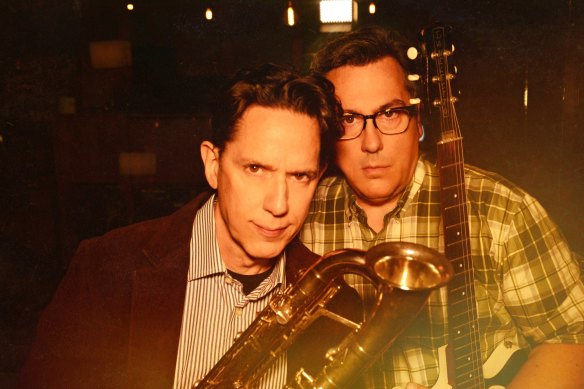
They Might Be Giants gave fans a lengthy show - and no Genesis.Credit:
They set the bar high at the outset with the bombastic Four Lads cover Istanbul (Not Constantinople), which segued into Linnell experimenting with a “chimpanzee theremin”, and kept meeting it over the next three hours.
Flood has 19 tracks and not all are classics. Sapphire Bullets of Pure Love gets used as a musical experiment, while the songs that mine similar vibes are spaced out among more varied material from across the decades.
Your Racist Friend feels more relevant than ever, lyrically, and the mid-song burst of guitar and horns surpasses the studio version. The 2024 version of Particle Man likewise seems better than the one recorded decades ago. The ever-delightful Birdhouse in Your Soul helped close out the first set (along with a Chumbawamba cover), while Whistling in the Dark and Road to Berlin were saved for the late stages of the second.
The non-Flood highlights were legion. The best inclusions from the 2021 “Grammy-losing album” Book were the wistful Moonbeam Rays early in the show and the absurd Synopsis for Latecomers some two dozen songs in. Country-tinged throwback Number Three was barnstorming, while Spy, a James Bond theme from an alternative universe, descends into vaudeville. Then there’s the undeniable brilliance of Doctor Worm, an allegory about identity and self-esteem that started as a Kiss joke and was presented to the world wrapped in an infectious, brassy ska tune.
Could you want more? If you did, there were two encores. There was not much by way of exodus from satisfied fans, and thankfully even less by way of Genesis.
They Might Be Giants tour continues in Brisbane, Melbourne and Perth.
Well-Behaved Women
Belvoir Theatre
October 2
(Until November 3)
Reviewed by JOYCE MORGAN
★★★★
Take a bunch of fabulous, famous and forgotten women across the aeons, give them a microphone and hear them roar.
This stirring and ultimately uplifting song cycle gives voice to the rage, resilience and courage of females who, throughout history, have defied the rules. Queens, warriors, artists, sportswomen.
The show’s title is tongue-in-cheek. Well-behaved women rarely make history, commented American historian Laurel Thatcher Ulrich back in 1976. It has since appeared on T-shirts, bumper stickers and now on Belvoir Theatre’s wall.
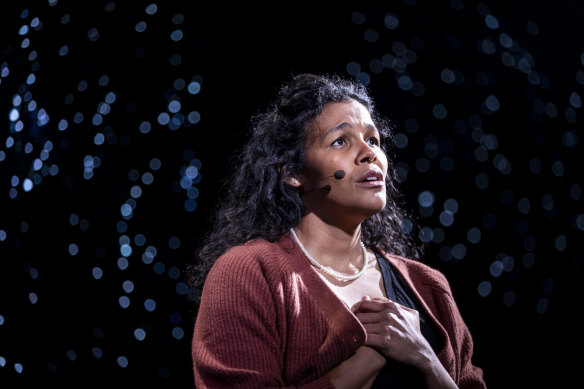
Zahra Newman is one of the “well behaved” women.Credit: Brett Boardman
Informed by the #MeToo Movement, the New York-based Australian composer/lyricist Carmel Dean has created a cycle of 16 songs – blues, ballads, gospel and country – that tap into the zeitgeist.
This exuberant concert-style show is a transfer of the 2021 Hayes Theatre production. It has retained the original cast of Zahra Newman, Ursula Yovich, Stefanie Caccamo and Elenoa Rokobaro, who deliver faultless performances.
The Biblical Eve (a sassy Newman) sets the tone and framework with her pointed opening song about original sin.
“In the beginning was it God’s plan, to make me the scapegoat for all of man? … I know women suffer because of me, let’s face it we’ve been f---ed throughout history.”
Yovich raises the tempo as a searing Boudica, full of murderous rage in Warrior Queen, about the ancient British tribal chief who led an uprising against Roman invaders.
The show comprises a series of solos, with the occasional duet or quartet.
It throws a spotlight on women across cultures and eras, although most are 20th and 21st-century figures. There’s Cleopatra, Frida Kahlo and Malala Yousafzai, as well as several Australian women, including Cathy Freeman, Fanny Durack, Mina Wylie and Julia Gillard.
The latter’s comic Fruit Bowl song brilliantly skewered the misogyny the former prime minister faced, including when she was photographed at home with an empty fruit bowl: “I don’t see any mockery of men and their crockery.”
The premise of the show, which premiered in New York in 2020, in a sense evokes a popular conceit: think of a dozen or so remarkable women – living, dead or mythic – who you would most want to invite to a dinner party.
While some of the music is serviceable rather than memorable, the lyrics and compelling performances give this show its power.
Dean’s gift as a storyteller is particularly strong in If Shakespeare Had a Sister, which Caccamo delivered with bell-like clarity as she channelled Virginia Woolf. Caccamo also delivered the evening’s comic high point as Mary Magdalene in a folksy country-style Only Girl at the Table.
As stories of injustice, indignity and defiance mount over 80 minutes, the sum feels greater than the parts.
The four diverse singers each deliver finely calibrated performances that complement each other and bring a depth of conviction and emotion to each number.
The show is directed with a light touch by Blazey Best and supported by a tight four-piece ensemble on stage throughout, directed by David Gardos.
Video director Susie Henderson utilises six video screens to introduce the characters or abstract imagery that adds atmosphere to an otherwise bare stage.
Grace Deacon’s muted palette of costumes helps put the emphasis on the women and their stories rather than their attire.
The timely show invites comparison with the recent musical Six, about the wives of Henry VIII, which offered a lively, contemporary feminist take on historic figures.
Well-Behaved Women is delivered with great verve and wit as it picks apart how the dice has been loaded against women. This show is right on key.
Seventeen
Reginald Theatre, Seymour Centre
October 1
Until October 19
Reviewed by HARRIET CUNNINGHAM
★★★
Matthew Whittet’s 2015 play, Seventeen, has a simple premise. Six characters meet in a park after their last day at school. They hang out, they drink their hard-won stash of stolen alcohol and, in the course of the night, they change forever. The kicker to this fertile ground is the casting: all six actors are veterans of Australian stage and screen, closer to seventy than seventeen.
As Mike, the alpha male, Peter Kowitz owns the stage. His best mate, Tom (a soft-spoken Noel Hodda), can barely keep up. Indeed, he’s not sure he wants to. Mike’s girlfriend, Sue (Di Adams) is a fun-loving sweetheart, while her bestie, Edwina (Katrina Foster), is a straight-laced school swot. Ronnie (Colin Moody) is in the park because he has nowhere else to go. Finally, the Puck-ish Lizzie (Di Smith), Mike’s annoying little sister, is there to bear witness to the transformations of a midsummer night’s dream.
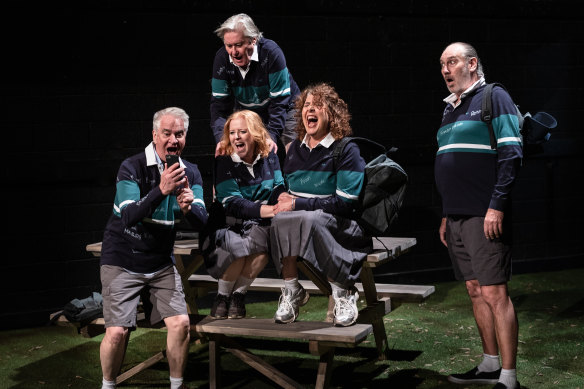
Noel Hodda, Peter Kowitz, Di Adams, Katrina Foster and Colin Moody in Seventeen.Credit: Carlita Sari
Director Mary-Anne Gifford plays it curiously straight to the point that you can almost forget that these actors are, in real life, old. They are, after all, acting; being someone they are not is the whole point of the exercise. But this successful suspension of disbelief undercuts the play’s power, taking it dangerously close to being a stage version of Heartbreak High.
A game of truth or dare plays out without major surprises; you can see the kiss coming a mile off; the nakedness and vomiting all happen offstage. Perhaps the most exhilarating moments of age inappropriateness come through in the characters’ dancing (choreographed by Sally Dashwood). Sue’s party piece is a hot mix of teenage self-consciousness, latent sexuality and childish delight, and Ronnie’s visceral response to the music is like seeing a caged animal set free.
But the whole point of the casting – having older actors playing seventeen-year-olds – feels like a joke simultaneously stretched too far and underplayed. When, on first night, Di Smith accidentally trips and falls (and bounces back up with admirable energy) those of us in the audience who are no longer seventeen gasp with concern. That must have hurt. But when they play out the heartbreak, the confusion, the sense of opportunity and of loss, the joy and intensity of being a teenager, it all feels utterly familiar. After all, there are no adults in this world. Only ageing children.
Gilgamesh
Opera Australia, Sydney Chamber Opera and Carriageworks
September 26
Until October 5
Reviewed by PETER McCALLUM
★★★★★
With a mere five singers, eleven instrumentalists and a cavernous space, composer Jack Symonds, librettist Louis Garrick and director Kip Williams have reforged an ancient epic into modern theatre of tumult and transcendence, rage and tenderness, destruction and creation.
Inscribed on clay tablets dating back at least four millennia, the story of Gilgamesh tells of his earthly glory in the city of Uruk, partnership with Enkidu, defiance of nature and gods, and journey to the netherworld in search of meaning. Gilgamesh is two-thirds god and one-third man; Enkidu, “born of silence”, is half man, half beast.
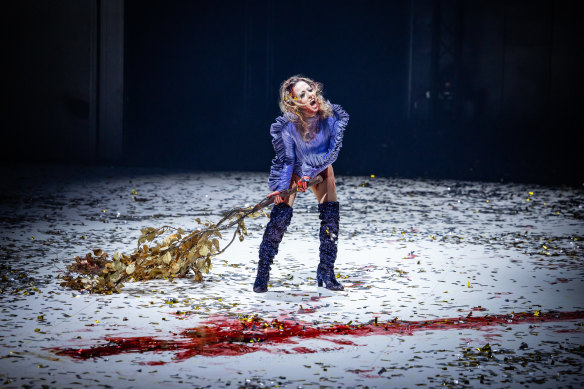
Jane Sheldon as Ishtar.Credit: Daniel Boud
Symonds and Garrick locate the tale at the intersection of the natural, the human and the divine worlds, making each act a transformation in which Gilgamesh moves from god-like pretensions to human love, and then, after human loss, to value the natural world. Ur-Shanabi, boatman over the Waters of Death, says pityingly towards the end that he “had everything but couldn’t see what was precious”.
With designers Elizabeth Gadsby (set), David Fleischer (costumes – when they hadn’t removed them) and Amelia Lever-Davidson’s barrage of lights at the back and sides, Williams fills the wide stage with discerning skill, creating a forest of obstacles and fears, a (literally) glittering palace, and, at the close a path of diminishing light towards the infinite.
The visual effects are arresting, inventive and occasionally humorous. Garrick’s text is epigrammatic and remote, populated with strange names, age-old metaphors and gnomic wisdom. Yet it is Symonds wide-ranging and varied score that energises and paces the drama, drawing us in to a world of writhing strangeness, urging the action forward with sharply accented intensity, drawing it back with unexpected sensuousness, and, at the end, sustaining a long expanse of spiritual transformation.
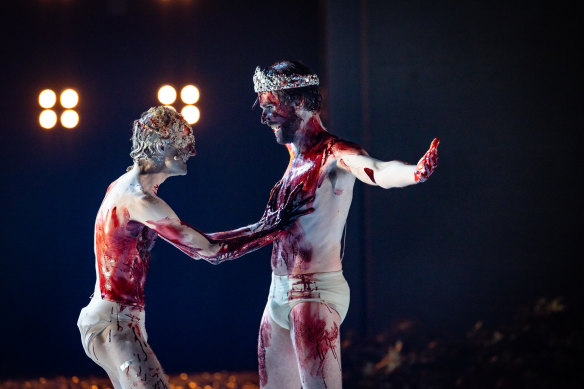
Mitchell Riley as Enkidu and Jeremy Kleeman as Gilgamesh.Credit: Daniel Boud
The musical language draws on modernist angularity and dissonance, caressing romantic lines, trite triumphalism, beckoning depth and the strangeness of electronic transformation (Benjamin Carey and Bob Scott).
For the outstanding cast, Symonds has crafted a vocal style unique to each singer. Jeremy Kleeman’s Gilgamesh is, in one sense, the most vocally straight, singing with chiselled strength in well-formed phrases. By contrast, Mitchell Riley, as Enkidu, flits between bestial howls, penetrating falsetto, eerie double notes and an earthy humanity, devoid of godly pretension.
Jane Sheldon’s main role is Ishtar goddess of love and war. After her rejected seduction, she spirals into splintered vocal derangement, with notes, screams and guttural convulsions gushing forward in a rage of destruction. Jessica O’Donoghue as the priestess Shamhat and later the wise Uta-Napishti, is the opposite in both voice and persona - smooth, seductive mysterious and other-worldly.
Daniel Szesiong Todd sings with strong defiance as Humbaba, (the terrifying guardian of the Forest of Cedars which Gilgamesh destroys), and then mutates to ethereal stillness as the boatman, silently mapping out circles of time. The ensemble, comprising the Australian String Quartet and Ensemble Offspring, is outstanding, realising the score’s wide range of textures and emotional states with incisive energy and alluring beauty.
The themes of overreach, destruction of nature and rebirth through love have some parallels with Wagner’s Ring. Symonds, Garrick and Williams have reimagined those themes with striking contemporary relevance.
Kip Moore
Darling Harbour Theatre, ICC, October 28
Reviewed by JAMES JENNINGS
★★½
They may appear polar opposites, but country music and gangsta rap are two sides of the same coin. The latter paints vivid urban tales filled with guns and offing your rivals, while the former romanticises rural life being all about working-class outlaws and pick-up trucks tearing down dusty roads.
For the most part, both are fantasy. But judging by the amount of cowboy boots, trucker caps and chambray shirts at tonight’s show for Georgia-born country singer Kip Moore, plenty of people are all in on the yeehaw cosplay. Moore is in on it, too, arriving wearing a bicep-showcasing white singlet, durable pants and big boots - the picture of a working-class hero, even if he’s likely capable of buying everyone in the audience a new car with plenty of change left over.
The songs played by Moore and the five musicians who join him - all skilled players - split into two camps: feel-good foot-stompers, and the occasional slow acoustic number deployed to give everyone a breather and Moore a chance to showcase his sensitive side.
The crowd sing along gleefully and Moore is an engaging performer who keeps energy levels high, creating a proper big-city hoedown.
The relentlessly upbeat songs soon become one note, but the most egregious element are the truly awful lyrics that tick every country cliche in the book. Moore’s world is all about beer (Beer Money: “You got the kiss that tastes like honey / And I got a little beer money”), dirt roads and beer (Dirt Road: “Unless [Heaven’s] got a dirt road / Leadin’ down to a fishin’ hole / With a little piece of moonlight / A couple cans of Bud Light”), and trucks, women and beer (Somethin’ ’Bout a Truck: “There’s somethin’ ’bout a truck in a field / And a girl in a red sundress with an ice-cold beer to her lips”).
It’s reminiscent to the rural America portrayed in the movies of director Michael Bay: all sepia-toned shots of cornfields and US flags waving in slow-motion. It’s harmless fun if you’re buying into the fantasy, but ultimately Moore is serving up the McDonald’s of country music: songs that offer instant gratification, but are ultimately devoid of substance or anything memorable.
ANDY SUMMERS
City Recital Hall, September 26
Reviewed by JOHN SHAND
★★★
He really should have had a band. Just bass and drums – like a certain previous trio that benefited from Andy Summers’ guitar playing. If you’re going to use backing tracks on virtually every song, it seems lame and even cheap not do what the music is telling you, and make it all as real as the guitar playing.
Called The Cracked Lens + A Missing String, the show is a retrospective of Summers’ musical career – before, during and after The Police – and his photography. It is also an elaborate travelogue and faltering stand-up routine – and somehow it wasn’t enough.
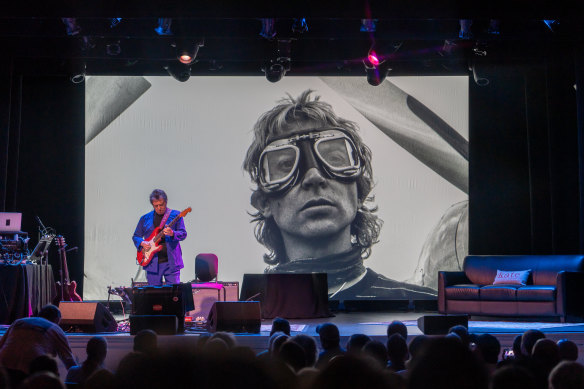
Summers’ photographs are routinely exceptional.Credit:
The jokey chat could be entertaining, or it could wander up blind alleys and expend itself against a wall. The photography, painstakingly edited and sometimes carefully choreographed to the music, was routinely exceptional. Mostly black-and-white, it revealed a keen eye for making the ordinary extraordinary, or for catching the special moment – whether that was plant life or a Balinese dancer.
The Police were out in greater force than I’d expected, and there was an undeniable fascination in hearing songs so wedded to Sting’s voice and words now rendered as instrumentals. The restrained Tea in the Sahara worked a treat, as did Message in a Bottle in a different way, including Summers’ most vigorous improvising of the night.
An amusing short film shot in Japan showed Summers wandering past a karaoke bar where someone was murdering Every Breath You Take. He went in, took part and was duly recognised. I don’t think it was staged.
Perhaps his finest guitar playing came when he told us about the enormous influence on his 16-year-old self of hearing Thelonious Monk live, and then played Round Midnight. Where countless versions have airbrushed this masterpiece into mere prettiness, Summers let some of Monk’s native dissonance re-enter the frame.
Yet the sound he chose here, as elsewhere – heavily treated; rather organ-like – was a barrier to any emotional immediacy, making the music oddly remote. A snapshot of the show as a whole, really.